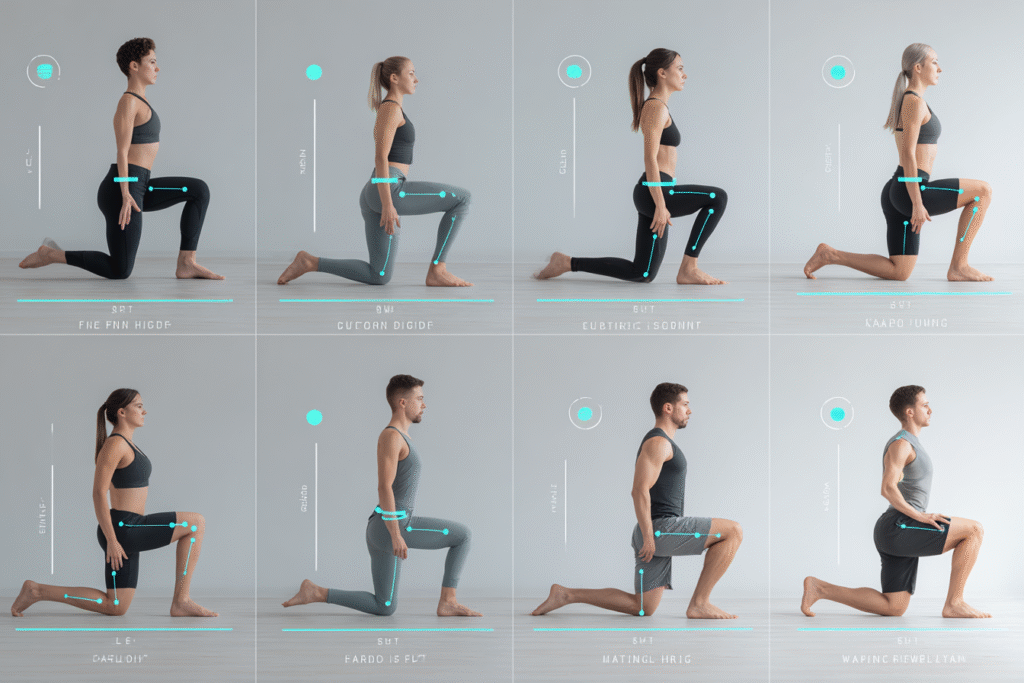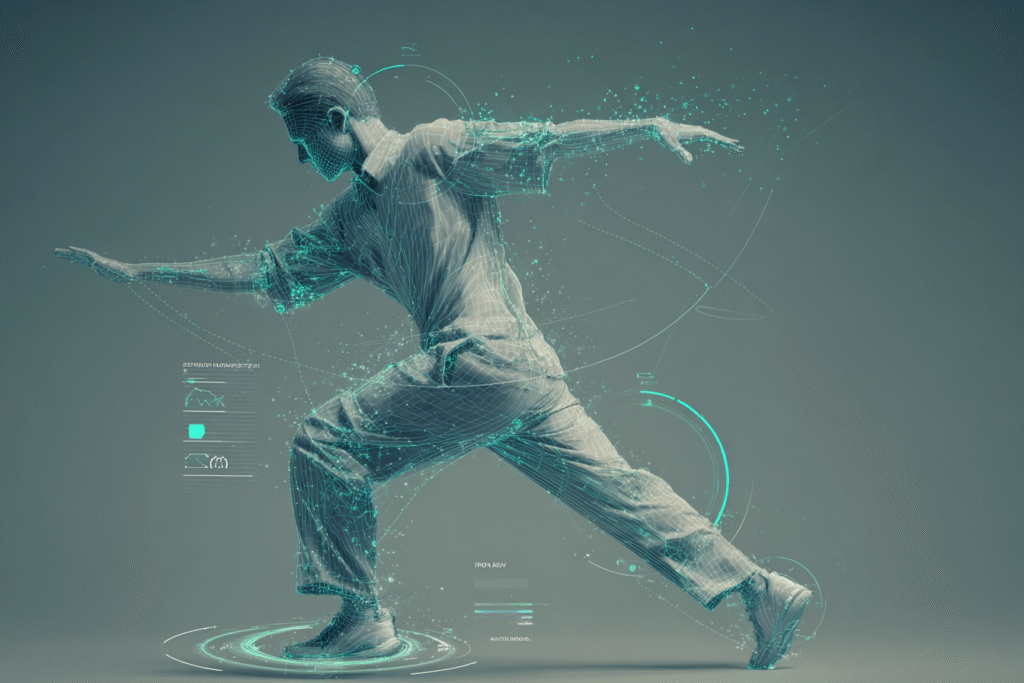Your body contains the blueprint for movements that can extend your life by decades—if you remember how to use them.
Note: This article is for educational and informational purposes only. See full disclaimer at the end.
Every time you reach for coffee without thinking, step out of a car, or lift a sleeping child, your body performs sophisticated movement patterns that took millions of years to perfect.
Yet somewhere between our desk jobs and machine-based fitness routines, we’ve lost touch with these natural movement blueprints that once defined human vitality.
What if the secret to longevity, cognitive sharpness, and physical resilience isn’t hidden in complex protocols or expensive technology, but coded into movements so fundamental that toddlers perform them instinctively?
Functional movement patterns have been with us for as long as our species has been able to move around. These patterns helped homosapiens, migrate, hunt, survive, adapt, and evolve over time.
Today, we’re going to rediscover these movement patterns that modern life has made us forget—and understand why they might be the most powerful health technology you already possess.
The Movement Revolution Your Body Needs
We’ve spent the last two insights exploring how consciousness enhances movement and how AI can optimize our training. Now it’s time to step back and examine the foundation beneath it all: the seven functional movement patterns that form the architecture of human motion.
These aren’t just exercises—they’re the biomechanical vocabulary your body uses to navigate the world. Research from the National Institute of Health demonstrates that functional movement training doesn’t just build strength; it creates neural pathways that enhance cognitive function, cardiovascular health, and metabolic efficiency [1].
When we train these patterns correctly, we’re not just preventing injury—we’re unlocking the full potential of human movement.
But here’s what makes functional movement patterns revolutionary: they’re simultaneously the most ancient and most modern approach to human optimization. While fitness trends come and go, these patterns remain constant because they’re written into our DNA.

The Science of Functional Movement
Traditional fitness often treats the body like a collection of individual muscles to be strengthened in isolation. Functional movement takes the opposite approach, recognizing that your body operates as an integrated system where every movement requires coordination between multiple muscle groups, joints, and neurological pathways.
Research published in the European Review of Aging and Physical Activity shows that functional training produces superior outcomes for real-world performance compared to traditional isolated exercises [2]. The reason is elegantly simple:
When you train patterns rather than muscles, you’re preparing your body for the demands it actually faces.
The Neurological Revolution
Perhaps most fascinating is what happens in your brain during functional movement.
Studies using neuroimaging technology reveal that functional movement patterns activate broader neural networks than isolated exercises [3]. When you perform a squat, you’re not just working your legs—you’re engaging proprioceptive systems, balance centers, and cognitive planning regions simultaneously.
This neural integration explains why functional movement training consistently produces improvements in cognitive function, particularly in executive functions like planning, problem-solving, and working memory [10]. Your brain literally becomes more connected and efficient when your body moves in natural patterns.
The Cardiovascular Connection
Functional movements also trigger unique cardiovascular adaptations that isolated exercises cannot match. Research from the Nature journal demonstrates that functional training produces superior improvements in cardiac output, oxygen delivery, and metabolic flexibility [4]. Because these movements recruit multiple muscle groups simultaneously, they create the kind of systemic demand that optimizes your entire cardiovascular system.

The Seven Pillars of Human Movement
Understanding functional movement begins with recognizing that virtually every human action can be categorized into seven fundamental patterns. These patterns emerged from our evolutionary development and remain the foundation of all complex movements.
1. The Squat: Your Foundation of Power
The squat pattern appears in every culture throughout human history, from Asian cultures that maintain deep squats for hours to the simple act of sitting and standing that punctuates your day. Research shows the squat pattern engages more muscle groups simultaneously than any other movement, making it perhaps the most important pattern for overall functional strength [14].
Biological Benefits:
- Musculoskeletal System: Strengthens quadriceps, glutes, hamstrings, and core while improving hip and ankle mobility
- Cardiovascular System: Elevates heart rate and promotes healthy blood flow return from lower extremities
- Nervous System: Enhances proprioception and balance while building neural coordination between upper and lower body
Daily Applications: Every time you sit in a chair, get in and out of a car, or pick up something from a low surface, you’re performing a squat pattern. The quality of this movement directly impacts your long-term joint health and independence.
2. The Hinge: Mastering Your Posterior Chain
The hip hinge is perhaps the most misunderstood movement pattern in modern life. We’ve been taught to “lift with our knees,” but research reveals that a properly executed hip hinge is actually safer and more powerful for most lifting tasks [15]. This pattern primarily engages your posterior chain—the muscles along the back of your body that are crucial for posture, power, and injury prevention.
Biological Benefits:
- Musculoskeletal System: Develops powerful glutes, hamstrings, and spinal erectors while protecting the lower back
- Metabolic System: Activates large muscle groups, creating significant metabolic demand and caloric expenditure
- Endocrine System: Stimulates growth hormone and testosterone production through compound muscle activation
Daily Applications: Picking up objects from the floor, loading groceries into your car, or lifting a suitcase all require proper hinge mechanics. Mastering this pattern is essential for lifelong back health.

3. The Lunge: Your Stability and Coordination Challenge
Lunging movements represent the complex interplay between locomotion and either squatting or hinging, depending on execution. This pattern challenges your body’s ability to maintain stability while moving through space—a crucial skill for everything from climbing stairs to avoiding falls [16].
Biological Benefits:
- Musculoskeletal System: Develops unilateral strength and identifies/corrects muscle imbalances between left and right sides
- Nervous System: Enhances balance, proprioception, and dynamic stability
- Cognitive Function: Requires coordination and planning, strengthening brain-body connections
Daily Applications: Walking up stairs, stepping over obstacles, or recovering from a stumble all depend on well-developed lunge patterns.
4. The Push: Your Upper Body Power Expression
Pushing movements involve moving objects away from your body or moving your body away from objects. These patterns are essential for functional upper body strength and form the foundation for everything from opening heavy doors to getting up from the ground [17].
Biological Benefits:
- Musculoskeletal System: Strengthens chest, shoulders, triceps, and core stabilizers
- Bone Health: Weight-bearing nature promotes bone density in arms, shoulders, and spine
- Functional Independence: Maintains ability to perform essential daily tasks throughout aging
Daily Applications: Push movements appear when you open doors, put items on high shelves, or push yourself up from lying positions.
5. The Pull: Countering Modern Posture Problems
Pulling movements involve bringing objects toward your body or pulling your body toward objects. These patterns are particularly crucial in our modern world, where forward head posture and rounded shoulders from desk work create muscular imbalances [4].
Biological Benefits:
- Musculoskeletal System: Strengthens the posterior deltoids, rhomboids, middle trapezius, and latissimus dorsi
- Postural Health: Counteracts forward head posture and rounded shoulders from prolonged sitting
- Grip Strength: Develops hand and forearm strength crucial for maintaining independence with age
Daily Applications: Pulling movements occur when you open doors, lift items from high shelves, or perform activities like gardening.

6. The Carry: Your Core Integration Pattern
Carrying movements require your body to maintain stability while transporting objects through space. This pattern integrates your entire kinetic chain and represents one of the most functional strengthening approaches available [19].
Biological Benefits:
- Core System: Develops true core stability through anti-flexion, anti-extension, and anti-rotation demands
- Cardiovascular System: Provides unique cardiovascular challenge through sustained muscle tension
- Grip Strength: Maintains hand and forearm strength crucial for functional independence
Daily Applications: Carrying groceries, luggage, children, or moving furniture all depend on well-developed carry patterns.
7. The Gait: Your Foundation of Locomotion
Walking and running represent the most fundamental human movement patterns. Quality gait mechanics influence everything from joint health to cognitive function, making this pattern essential for lifelong vitality [20].
Biological Benefits:
- Cardiovascular System: Provides low-impact cardiovascular conditioning with minimal joint stress
- Cognitive Function: Walking, particularly in natural environments, enhances creativity and reduces stress
- Longevity: Research shows that walking speed is a reliable predictor of overall health and longevity
Daily Applications: Every step you take throughout the day contributes to or detracts from your overall movement quality and health.

Patterns in Action: How They Interlock
Individual movement patterns are important, but the real magic happens when they integrate.
Consider what happens when you hear your phone ring from across the room while you’re sitting at your desk. You perform a rotation to turn toward the sound, a hinge to lean forward, a squat to rise from your chair, gait patterns to walk across the room, a lunge to reach down, and a pull to pick up the device.
This entire sequence—executed in seconds without conscious thought—demonstrates the elegant choreography of functional movement patterns.
Research from the Functional Movement Systems organization shows that people who can perform all seven patterns with good quality have significantly lower injury rates and better long-term health outcomes [5]. The patterns create a synergistic effect where mastery of one enhances performance in all others.
The Three Levels of Movement Mastery
Not all movement is created equal. The research identifies three levels of movement quality:
- Dysfunctional Movement: Patterns performed with compensations that increase injury risk
- Functional Movement: Patterns performed correctly but without optimization
- Performance Movement: Patterns performed with efficiency, power, and precision
The goal isn’t to reach elite performance levels in every pattern, but to establish functional competency that supports your daily life and long-term health goals.
The Mind-Body Integration: Movement and Cognitive Function
Building on our previous exploration of movement and consciousness, functional movement patterns create unique opportunities for cognitive enhancement. Research published in the journal Frontiers in Psychology demonstrates that complex movement patterns requiring coordination and balance produce greater cognitive improvements than simple, isolated exercises [6].
The Neuroplasticity Connection
When you perform functional movements, your brain must integrate information from multiple sensory systems: vision, vestibular (balance), and proprioceptive (body position) inputs. This integration strengthens neural pathways and promotes neuroplasticity—your brain’s ability to form new connections and adapt.
Studies show that people who regularly engage in functional movement training maintain cognitive function better as they age and have lower rates of cognitive decline [11]. The movements literally keep your brain young by challenging it in ways that isolated exercises cannot.
The Attention and Focus Benefits
Functional movements require present-moment awareness and coordination, naturally developing the same attention skills that meditation practices cultivate. This creates a unique opportunity to combine physical training with mindfulness practice, amplifying the benefits of both.

The Longevity Revolution: Movement as Medicine
Perhaps the most compelling aspect of functional movement patterns is their impact on longevity and quality of life. The Frontiers research on “Longevity with Functionality and Quality of Life” reveals that functional movement capacity is one of the strongest predictors of healthy aging [7].
The Independence Factor
Research consistently shows that people who maintain functional movement patterns preserve their independence longer and require less medical intervention as they age [8]. The ability to squat down and stand up, carry groceries, and navigate stairs without assistance directly correlates with quality of life in later years.
The Metabolic Optimization
Functional movements create unique metabolic demands that isolated exercises cannot match. Research from the National Institute for Fitness & Sport demonstrates that functional training provides superior metabolic benefits compared to traditional exercise approaches [12].
Because they engage multiple systems in concert, they:
- Boost insulin sensitivity
- Enhance mitochondrial energy output
- Regulate key hormones
- Support optimal body composition
The Cardiovascular Longevity
Studies published in Signal Transduction and Targeted Therapy demonstrate that functional movement training produces superior cardiovascular adaptations compared to traditional exercise approaches [18]. The multi-system integration required by functional patterns optimizes heart health, circulation, and metabolic efficiency.
Building Your Functional Movement Foundation
Understanding the patterns is only the beginning. The key to unlocking their benefits lies in systematic development and progressive application.

Step 1: Assess Your Movement Blueprint
Before developing your functional movement practice, it’s crucial to assess your current capabilities. Research shows that movement quality is more important than movement quantity, making assessment the foundation of effective training [9].
Simple Self-Assessment Protocol:
- Squat Assessment: Can you squat down with your feet flat on the ground and maintain an upright torso?
- Hinge Assessment: Can you bend forward at the hips while keeping your back straight and knees slightly bent?
- Lunge Assessment: Can you step forward into a lunge position and return to standing without losing balance?
- Push Assessment: Can you perform a full push-up or modified push-up with proper form?
- Pull Assessment: Can you hang from a bar or perform a rowing motion with proper shoulder blade engagement?
- Carry Assessment: Can you walk while carrying objects without compensating your posture?
- Gait Assessment: Can you walk with smooth, coordinated movement without pain or restriction?
Step 2: Build Better Movement
Once you’ve assessed your current capabilities, the development phase focuses on improving movement quality before adding load or complexity.
Foundation Development Protocol:
Week 1-2: Movement Quality
- Focus on bodyweight versions of each pattern
- Emphasize proper form over repetitions
- Practice patterns daily in short sessions (5-10 minutes)
Week 3-4: Movement Integration
- Begin combining patterns in sequence
- Add light resistance where appropriate
- Maintain focus on quality over quantity
Week 5-6: Movement Application
- Apply patterns to daily activities with conscious attention
- Gradually increase complexity and load
- Begin practicing patterns under fatigue

Step 3: Make It Your Lifestyle
The ultimate goal is to integrate functional movement patterns into your daily life so seamlessly that they become automatic. This integration creates a lifestyle that continuously reinforces optimal movement quality.
Daily Integration Strategies:
Morning Activation (5 minutes):
- Perform each pattern 3-5 times as a movement warm-up
- Focus on quality and awareness rather than intensity
- Use this as a daily movement assessment
Workday Integration:
- Use squat patterns instead of bending over when possible
- Take walking breaks to maintain gait quality
- Perform desk-friendly rotations and reaches throughout the day
Evening Practice (10 minutes):
- Use functional movements as a transition from work to personal time
- Focus on patterns that counter the day’s repetitive positions
- Combine movement with mindfulness or breathing practices
Technology Integration: Enhancing Natural Movement
Building on our previous exploration of AI-enhanced training, functional movement patterns provide an ideal foundation for technology integration.
Unlike isolated exercises that can become overly dependent on technology, functional patterns remain inherently natural while benefiting from technological enhancement.
Remember the AI training systems we explored in the last insight? Those sophisticated algorithms become most effective when they’re analyzing and optimizing these fundamental movement patterns.
The technology amplifies what’s already optimal in human movement rather than replacing it.

Movement Quality Analysis
Modern motion analysis can help identify compensations and imbalances in your functional movement patterns that might be invisible to the naked eye. This technology can accelerate improvement by providing objective feedback on movement quality.
Progressive Overload Optimization
AI systems can help determine optimal loading strategies for functional patterns, ensuring you progress safely while maximizing adaptation. The complex nature of functional movements benefits from intelligent programming that considers multiple variables simultaneously.
Recovery and Adaptation Monitoring
Wearable technology can track how functional movement training affects your recovery, sleep quality, and overall physiological adaptation, allowing for more precise program adjustments.
Common Pitfalls and How to Avoid Them
Even with the best intentions, certain mistakes can limit the effectiveness of functional movement training or increase injury risk.
Pitfall 1: Rushing Progression
The compound nature of functional movements means they require more neurological adaptation than isolated exercises. Rushing progression often leads to compensation patterns that reduce effectiveness and increase injury risk.
Solution: Focus on movement quality for at least 2-3 weeks before adding significant load or complexity.
Pitfall 2: Ignoring Individual Limitations
Not everyone can or should perform every movement pattern identically. Individual anatomy, injury history, and lifestyle factors all influence optimal movement patterns.
Solution: Adapt patterns to your individual capabilities rather than forcing perfect textbook form.
Pitfall 3: Neglecting Daily Application
Functional movement training is most effective when it carries over into daily life. Practicing perfect squats in the gym but continuing to bend over incorrectly throughout the day limits the benefits.
Solution: Consciously apply functional movement principles to daily activities, treating life as an extension of your training.
Pitfall 4: Overcomplicating the Process
The beauty of functional movement lies in its simplicity. Overcomplicating patterns with excessive variations or complex equipment often reduces effectiveness.
Solution: Master the basic patterns before progressing to advanced variations or equipment.

The Science Behind the Patterns
The effectiveness of functional movement patterns is supported by extensive research across multiple disciplines. Understanding the science helps maintain motivation and guides intelligent application.
Biomechanical Efficiency
Functional movement patterns follow the principles of biomechanical efficiency, utilizing optimal lever arms, joint mechanics, and muscle activation patterns. This efficiency reduces energy expenditure while maximizing force production.
Neurological Integration
These patterns require integration between multiple brain regions, promoting neuroplasticity and cognitive function. The complex coordination required strengthens neural pathways in ways that isolated movements cannot match.
Metabolic Optimization
The multi-muscle recruitment of functional patterns creates superior metabolic demand, promoting fat loss, muscle building, and cardiovascular adaptation more effectively than isolated exercises.
Hormonal Benefits
Research shows that functional movement patterns optimize hormone production, including growth hormone, testosterone, and insulin-like growth factor, while reducing stress hormones like cortisol.
Your Daily Movement Prescription
Based on current research and practical application, here’s your evidence-based approach to implementing functional movement patterns:
The Minimum Effective Dose
Research suggests that as little as 10–15 minutes of daily functional movement practice can produce significant health benefits [13]. The key is consistency rather than intensity.
Daily Essential Pattern Practice:
- 5 bodyweight squats
- 5 hip hinges (bodyweight good mornings)
- 5 lunges per side
- 5 push-ups (modified as needed)
- 5 pull movements (resistance band or towel rows)
- 1-minute carry (books, water bottles, or bodyweight)
- 2-3 minutes of mindful walking

The Optimization Protocol
For those seeking maximum benefits, research supports a more comprehensive approach that dedicates specific time to movement pattern development.
Three-Day Rotation:
Day 1: Lower Body Focus
- Squat pattern development
- Hinge pattern development
- Lunge pattern integration
- Gait quality practice
Day 2: Upper Body Focus
- Push pattern development
- Pull pattern development
- Carry pattern practice
- Rotation integration
Day 3: Integration and Play
- Combined movement patterns
- Movement flow sequences
- Sport or recreational activities
- Recovery and mobility work
Functional movement is more than reps and sets—it’s a philosophy for how you live inside your body. Before we close, let’s zoom out and explore the deeper meaning behind these primal patterns.
Beyond Exercise: A Philosophy of Movement
Functional movement patterns represent more than an exercise methodology—they embody a philosophy of human optimization that recognizes movement as fundamental to human flourishing.
Movement as Language
Your body speaks through movement, communicating health, vitality, and capability to yourself and others. When your movement patterns are clear and confident, they project and reinforce those same qualities internally.
Movement as Medicine
The research clearly demonstrates that functional movement patterns provide therapeutic benefits that extend far beyond traditional fitness outcomes. They influence cognitive function, emotional regulation, and systemic health in ways that make them truly medicinal.
Movement as Connection
In our increasingly digital world, functional movement patterns reconnect us with our physical selves and our environment. They remind us that we are embodied beings designed for movement, not sedentary observers of life.

The Integration Challenge: Making It Stick
Knowledge without application remains merely intellectual curiosity. The true test of functional movement patterns lies not in understanding them, but in integrating them into your daily life until they become unconscious competencies.
The 30-Day Challenge
Commit to practicing the daily essential pattern practice for 30 consecutive days. This timeframe allows for neurological adaptation while establishing a sustainable habit foundation.
The Awareness Practice
Throughout your day, pause occasionally to notice how you’re moving. Are you using functional patterns or falling into compensatory habits? This awareness practice gradually shifts your default movement patterns toward optimal function.
The Quality Focus
Rather than counting repetitions or tracking metrics, focus on the quality of each movement. How does it feel? Are you maintaining good alignment? Is the movement smooth and coordinated? This internal focus develops the body awareness that makes functional movement truly beneficial.
Your Next Steps
You now understand that functional movement patterns are not just exercises—they’re the foundation of human vitality, cognitive sharpness, and longevity. These seven patterns represent millions of years of evolutionary optimization, refined by modern science into practical tools for daily life.

The question isn’t whether functional movement patterns work—the research conclusively demonstrates their effectiveness. The question is whether you’ll take the simple yet profound step of returning to your body’s natural movement vocabulary.
Your body remembers these patterns, even if your conscious mind has forgotten them.
Each squat, hinge, and lunge you perform with intention isn’t just movement—it’s a declaration. A quiet rebellion against decline. A daily vote for the strong, agile, and fully alive version of you waiting to emerge.
Every day you apply these patterns to real life is an investment in your long-term independence and quality of life.
The sophisticated fitness technology and AI optimization we’ve explored in previous days all build upon this foundation. But remember: the most advanced movement technology ever created is already with you—it’s your body, evolved over millennia to move with grace, power, and efficiency.
Start where you are. Use what you have. Do what you can. Your future self will thank you for every functional movement you practice today.
See you in the next insight.
Comprehensive Medical Disclaimer: The insights, frameworks, and recommendations shared in this article are for educational and informational purposes only. They represent a synthesis of research, technology applications, and personal optimization strategies, not medical advice. Individual health needs vary significantly, and what works for one person may not be appropriate for another. Always consult with qualified healthcare professionals before making any significant changes to your lifestyle, nutrition, exercise routine, supplement regimen, or medical treatments. This content does not replace professional medical diagnosis, treatment, or care. If you have specific health concerns or conditions, seek guidance from licensed healthcare practitioners familiar with your individual circumstances.
References
The references below are organized by study type. Peer-reviewed research provides the primary evidence base, while systematic reviews synthesize findings across multiple studies for broader perspective.
Peer-Reviewed / Academic Sources
- [1] Mandolesi, L., et al. (2018). Effects of Physical Exercise on Cognitive Functioning and Wellbeing: Biological and Psychological Benefits. Frontiers in Psychology, 9, 509. https://pmc.ncbi.nlm.nih.gov/articles/PMC5934999/
- [2] Liu, C., et al. (2014). Systematic review of functional training on muscle strength, physical functioning, and activities of daily living in older adults. European Review of Aging and Physical Activity, 11, 95-106. https://eurapa.biomedcentral.com/articles/10.1007/s11556-014-0144-1
- [3] Leisman, G. (2018). The Effect of Movement on Cognitive Performance. Frontiers in Public Health, 6, 100. https://www.frontiersin.org/articles/10.3389/fpubh.2018.00100/full
- [4] Bernardo, B., et al. (2022). Exercise training maintains cardiovascular health: signaling pathways involved and potential therapeutics. Signal Transduction and Targeted Therapy, 7, 306. https://www.nature.com/articles/s41392-022-01153-1
- [5] Cook, G., et al. (2014). Functional movement screening: the use of fundamental movements as an assessment of function-part 1. International Journal of Sports Physical Therapy, 9(4), 396-409. https://pmc.ncbi.nlm.nih.gov/articles/PMC4060319/
- [6] Ratey, J., & Loehr, J. (2023). Move Your Body, Boost Your Brain: The Positive Impact of Physical Activity on Cognition. Biomedicines, 11(6), 1765. https://www.mdpi.com/2227-9059/11/6/1765
- [7] Editorial Team. (2023). Editorial: Longevity with functionality and quality of life. Frontiers in Medicine, 10, 1314551. https://pmc.ncbi.nlm.nih.gov/articles/PMC10684901/
- [8] Zhang, Y., et al. (2023). Effects of physical exercise on physical function in older adults in residential care. The Lancet Healthy Longevity, 4(5), e188-e196. https://www.sciencedirect.com/science/article/pii/S2666756823000570
- [9] Wang, C., et al. (2022). Effects of Exercise-Based Interventions on Functional Movement Capability in Untrained Populations: A Systematic Review and Meta-Analysis. International Journal of Environmental Research and Public Health, 19(16), 9874. https://pmc.ncbi.nlm.nih.gov/articles/PMC9368594/
Government / Institutional Sources
- [10] McGinnis, S. (2024). Exercise can boost your memory and thinking skills. Harvard Health Publishing. https://www.health.harvard.edu/mind-and-mood/exercise-can-boost-your-memory-and-thinking-skills
- [11] CDC. (2025). Physical Activity Boosts Brain Health. Centers for Disease Control and Prevention. https://www.cdc.gov/physical-activity/features/boost-brain-health.html
- [12] NIFS. (2024). Functional Training for Longevity. National Institute for Fitness & Sport. https://www.nifs.org/blog/functional-training-for-longevity
- [13] Institute for Functional Medicine. (2024). Exercise Routines: Movement for a Fit Heart. https://www.ifm.org/articles/exercise-routines-movement-for-a-fit-heart
Industry / Technology Sources
- [14] Rusin, J. (2018). 6 Foundational Movement Patterns That Every Person On Earth Needs To Master. DrJohnRusin.com. https://drjohnrusin.com/6-foundational-movements-that-every-person-on-earth-needs-to-master/
- [15] Gentilcore, T. (2024). The 7 Fundamental Movement Patterns Your Program Needs. BarBend. https://barbend.com/fundamental-movement-patterns/
- [16] Hoobler, J. (2022). Functional training: What is it and what are the benefits? Live Science. https://www.livescience.com/what-is-functional-training
- [17] Zuniga, L. (2021). 6 Essential Functional Movements. Body Glide. https://bodyglide.com/blog/6-essential-functional-movements/
- [18] John, D., & Whitley, D. (2020). The Seven Basic Human Movements. StrongFirst. https://www.strongfirst.com/seven-basic-human-movements/
- [19] Barroso, J. (2024). The 7 Functional Movement Patterns for Strength Training. Strength by Jaime Barroso. https://www.strengthbyjaimebarroso.com/articles-1/7-functional-movement-patterns-for-strength-training
- [20] Dase, J. (2021). 7 Functional Fitness Moves Trainers Say Are the Biggest Indicators of Longevity. Well+Good. https://www.wellandgood.com/functional-fitness-moves-longevity/


